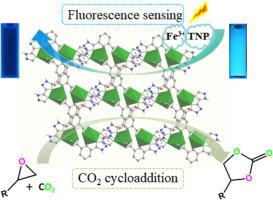双三唑基Cd(II)配位聚合物的结构研究及其在水中TNP和Fe3+的高效检测和催化CO2环加成中的应用
IF 4.7
2区 化学
Q2 CHEMISTRY, PHYSICAL
引用次数: 0
摘要
在溶剂热条件下合成了一种新的配位聚合物[Cd(H2tdpt)(H2O)]·5H2O (Cd- cp -1, H4tdpt = 3-(三唑-5-基)-5-(3,5-二羧基苯基)三唑),并对其进行了结构表征。x射线单晶衍射结果表明,Cd-CP-1呈一维阶梯状双链结构,并通过π-π叠加和链间氢键(O- h··O)相互作用进一步结合成三维结构。Cd-CP-1不仅具有优异的化学稳定性和pH稳定性,而且具有优异的荧光特性,可作为选择性检测水中2,4,6-三硝基苯酚(TNP)和Fe3+的荧光传感器,具有低检出限和短的检测响应时间(TNP为18 s, Fe3+为12 s)。利用粉末x射线衍射(PXRD)、紫外-可见(UV-vis)吸收光谱、x射线光电子能谱(XPS)和密度泛函理论(DFT)分析了可能的传感机理。此外,活化后的Cd-CP-1 (Cd-CP-1a)具有非配位的氮三唑和羧酸盐原子作为Lewis碱位点,不饱和的Cd2+离子作为Lewis酸位点,可以分别增强CO2和环氧化物的活化。结果表明,Cd-CP-1a在无溶剂的温和条件下(1 atm CO2, 70°C),对CO2与环氧化物的环加成反应具有较高的催化活性。此外,Cd-CP-1可以重复使用至少5个循环,而催化活性没有明显下降。这项工作为配位聚合物在污染物检测和CO2环加成中的应用提供了有用的信息。本文章由计算机程序翻译,如有差异,请以英文原文为准。

Structural study of a bistriazole-based Cd(II) coordination polymer and its application in highly effective detection of TNP and Fe3+ in water and in catalytic CO2 cycloaddition
A new coordination polymer, namely, [Cd(H2tdpt)(H2O)]·5H2O (Cd-CP-1, H4tdpt = 3-(triazol-5-yl)-5-(3,5-dicarboxy phenyl)triazole) was synthesized under solvothermal conditions and structurally characterized. X-ray single crystal diffraction revealed that Cd-CP-1 exhibited a one-dimensional (1D) ladder-shaped double chain structure, and the chains were further associated into a 3D architecture through π-π stacking and interchain hydrogen bonding (O-H···O) interactions. Cd-CP-1 not only exhibited outstanding chemical and pH stability but also possessed excellent fluorescence properties, which could function as a fluorescent sensor for the selective detection of 2,4,6-trinitrophenol (TNP) and Fe3+ in water with low detection limits, and short sensing response times (18 s for TNP, 12 s for Fe3+). Moreover, the possible sensing mechanisms were analyzed in detail by using powder X-ray diffraction (PXRD), ultraviolet-visible (UV-vis) absorption spectra, X-ray photoelectron spectra (XPS) and density functional theory (DFT). In addition, the activated Cd-CP-1 (Cd-CP-1a) featured uncoordinated Ntriazole and Ocarboxylate atoms acting as Lewis base sites and unsaturated Cd2+ ions serving as Lewis acid sites, which can enhance the activation of CO2 and epoxides, respectively. As a result, Cd-CP-1a exhibited high catalytic activity for the cycloaddition reaction of CO2 with epoxide into cyclic carbonates under mild conditions (1 atm CO2, 70°C) in the absence of solvent. Moreover, Cd-CP-1 could be reused for at least five cycles without an obvious decrease in catalytic activity. This work provides useful information on the applications of coordination polymers in contaminant detection and CO2 cycloaddition.
求助全文
通过发布文献求助,成功后即可免费获取论文全文。
去求助
来源期刊

Journal of Molecular Structure
化学-物理化学
CiteScore
7.10
自引率
15.80%
发文量
2384
审稿时长
45 days
期刊介绍:
The Journal of Molecular Structure is dedicated to the publication of full-length articles and review papers, providing important new structural information on all types of chemical species including:
• Stable and unstable molecules in all types of environments (vapour, molecular beam, liquid, solution, liquid crystal, solid state, matrix-isolated, surface-absorbed etc.)
• Chemical intermediates
• Molecules in excited states
• Biological molecules
• Polymers.
The methods used may include any combination of spectroscopic and non-spectroscopic techniques, for example:
• Infrared spectroscopy (mid, far, near)
• Raman spectroscopy and non-linear Raman methods (CARS, etc.)
• Electronic absorption spectroscopy
• Optical rotatory dispersion and circular dichroism
• Fluorescence and phosphorescence techniques
• Electron spectroscopies (PES, XPS), EXAFS, etc.
• Microwave spectroscopy
• Electron diffraction
• NMR and ESR spectroscopies
• Mössbauer spectroscopy
• X-ray crystallography
• Charge Density Analyses
• Computational Studies (supplementing experimental methods)
We encourage publications combining theoretical and experimental approaches. The structural insights gained by the studies should be correlated with the properties, activity and/ or reactivity of the molecule under investigation and the relevance of this molecule and its implications should be discussed.
 求助内容:
求助内容: 应助结果提醒方式:
应助结果提醒方式:


